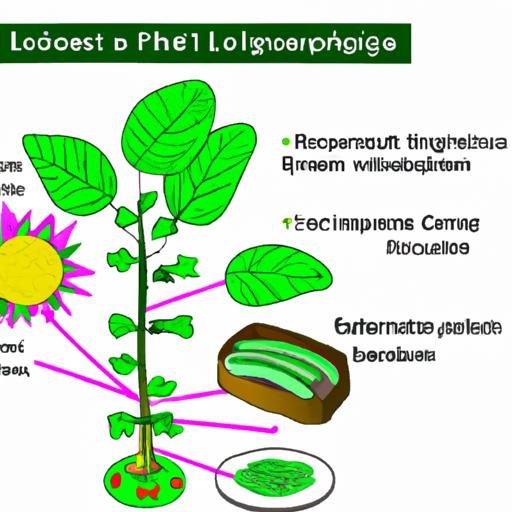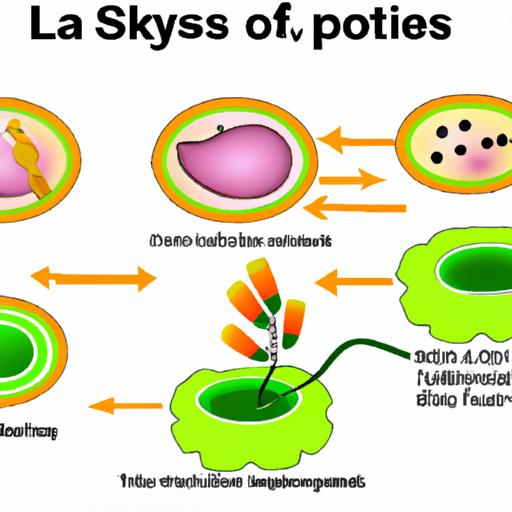Plants, just like animals, are living organisms that require energy to grow, develop, and carry out their vital functions. But have you ever wondered how plants obtain this energy? In this article, we will delve into the fascinating world of plant physiology and explore the concept of cellular respiration.
Introduction
Cellular respiration is a fundamental biological process that occurs in all living organisms, including plants. It is the process by which cells convert organic compounds, such as sugars, into usable energy in the form of ATP (adenosine triphosphate). While we often associate respiration with breathing in animals, plants have their unique way of fulfilling their energy requirements.
Plants, despite their stationary nature, have intricate systems that allow them to carry out cellular respiration efficiently. Through this process, plants break down sugars, produced during photosynthesis, to release energy. But how exactly does this process work, and what role does it play in the life of a plant?
Overview of Plant Physiology and Energy Requirements
To comprehend how plants undergo cellular respiration, we must first grasp the basics of plant physiology. Plants are composed of specialized cells that work together to perform various functions necessary for their survival. These functions include photosynthesis, respiration, and transpiration, among others.
Photosynthesis, the process by which plants convert sunlight into energy-rich organic compounds, is often the focus of attention. However, respiration is equally vital for plant survival. While photosynthesis allows plants to generate their own food, cellular respiration ensures that this food is broken down and converted into usable energy.
Plants require energy not only for growth and development but also for essential activities such as nutrient uptake, reproduction, and defense against environmental stressors. Hence, cellular respiration plays a crucial role in meeting these energy demands.
As we embark on this journey to understand plant respiration, let us explore the stages involved in this intricate process and unravel the significance it holds for plant life. Join me as we dive deeper into the fascinating world of plant cellular respiration and unlock the secrets hidden within the green foliage.
Understanding Cellular Respiration
A. Definition of Cellular Respiration
Cellular respiration can be defined as the biochemical process that occurs within cells to convert organic molecules, such as glucose, into energy in the form of ATP. This process occurs in the mitochondria, the powerhouse of the cell, where various enzymatic reactions take place.
B. Explanation of Its Role in Energy Production
The primary purpose of cellular respiration is to generate ATP, the energy currency of the cell. Through a series of chemical reactions, the organic molecules derived from food are broken down, releasing energy that is captured and stored in ATP molecules. This energy is then readily available for the plant to carry out various cellular processes and maintain its vital functions.
C. Comparison of Aerobic and Anaerobic Respiration
Cellular respiration can occur in two main ways: aerobic respiration and anaerobic respiration. Aerobic respiration is the most common type and requires oxygen to proceed. It is a highly efficient process that yields a substantial amount of ATP. During aerobic respiration, glucose is completely broken down into carbon dioxide and water, with oxygen serving as the final electron acceptor.
On the other hand, anaerobic respiration occurs in the absence of oxygen. While it is less efficient in terms of ATP production, it allows cells to generate energy when oxygen is limited. In plants, anaerobic respiration can occur in certain conditions, such as waterlogged soils where oxygen availability is restricted. Instead of oxygen, alternative electron acceptors, such as nitrate or sulfate, are used in this process.
Understanding the different types of respiration is crucial as it sheds light on how plants adapt to different environments and cope with varying oxygen levels. By comprehending the intricacies of cellular respiration, we can gain a deeper appreciation for the remarkable ways in which plants obtain and utilize energy.
Plant Respiration Process
Overview of Plant Respiration
Plant respiration is a complex biochemical process that occurs within the cells of plants. It involves the breakdown of organic compounds, such as sugars, to release energy in the form of ATP. While respiration in plants shares similarities with respiration in animals, there are notable differences in the mechanisms and outcomes.
In plants, respiration takes place in various parts of the plant, including leaves, stems, and roots. The process is ongoing, even during periods of low light or darkness when photosynthesis is limited. This highlights the importance of respiration as a continuous energy-producing pathway for plants.
Description of the Stages Involved
Plant respiration can be divided into three main stages: glycolysis, the Krebs cycle (also known as the citric acid cycle or TCA cycle), and oxidative phosphorylation.
-
Glycolysis: This initial stage occurs in the cytoplasm of plant cells and involves the breakdown of glucose into two molecules of pyruvate. It is an anaerobic process that does not require oxygen.
-
Krebs Cycle: The pyruvate molecules produced in glycolysis enter the mitochondria, where they undergo further breakdown in the Krebs cycle. This stage generates energy-rich molecules, including NADH and FADH2.
-
Oxidative Phosphorylation: The final stage takes place in the inner mitochondrial membrane. Here, the NADH and FADH2 molecules produced in the previous stages are used to generate ATP through a series of electron transfer reactions.
Discussion on the Importance of Respiration in Plants
Respiration is vital for plants as it provides them with the energy needed for various physiological processes. It plays a crucial role in driving plant metabolism, allowing cells to carry out essential functions such as nutrient uptake, protein synthesis, and cell division.
Furthermore, respiration enables plants to respond to environmental changes and stressors. For example, during periods of low light or limited photosynthesis, plants rely on respiration to meet their energy demands. Additionally, respiration aids in the breakdown of stored carbohydrates, such as starch, to provide energy for growth and reproduction.
Overall, understanding the plant respiration process and its significance underscores the intricate balance between photosynthesis and respiration in sustaining plant life. The interplay between these two processes ensures the efficient conversion of sunlight into energy and the continuous growth and survival of plants.
Factors Influencing Plant Respiration
Plant respiration is a complex process that can be influenced by various factors. Understanding these factors is crucial to comprehend how plants adapt and respond to their environment. Let’s explore some key factors that have a significant impact on plant respiration.
A. Temperature and its Impact on Plant Respiration
Temperature plays a vital role in plant respiration. As the temperature rises, the rate of respiration generally increases. This is because higher temperatures accelerate metabolic reactions within the plant cells, leading to an increased demand for energy. Consequently, plants respire more to meet this heightened energy requirement.
On the other hand, extremely high temperatures can have a detrimental effect on plant respiration. Beyond a certain threshold, the excessive heat can disrupt cellular processes, causing a decline in respiration rates. This can have severe consequences for plant growth and overall health.
B. Light Intensity and its Effect on Respiration Rate
Light intensity, another crucial factor, can impact plant respiration. During photosynthesis, plants convert light energy into chemical energy, which is then stored in the form of sugars. However, in the absence of light or under low light conditions, plants rely on stored energy reserves through respiration.
Interestingly, under moderate light conditions, plants can strike a balance between photosynthesis and respiration. They can generate enough energy through photosynthesis to meet their immediate needs, reducing the reliance on respiration. Conversely, in low light conditions, respiration becomes the primary source of energy production.
C. Water Availability and its Influence on Respiration
Water availability is essential for plant respiration. Adequate water supply ensures the proper functioning of plant cells, facilitating enzymatic reactions involved in respiration. Insufficient water can lead to cellular dehydration and adversely affect respiration rates.
During periods of drought or limited water availability, plants often close their stomata to reduce water loss through transpiration. However, this also restricts the entry of carbon dioxide, which is crucial for respiration. As a result, respiration rates may decrease, causing a potential energy crisis for the plant.
Understanding these factors and their effects on plant respiration is crucial for optimizing plant growth and productivity. By manipulating these factors, we can create favorable conditions that promote efficient respiration and ultimately enhance the overall health and vigor of plants.
Significance of Plant Respiration
Plants have evolved an intricate system of cellular respiration to meet their energy requirements. Understanding the significance of this process is crucial in appreciating the vital role it plays in plant growth, development, and overall survival.
Role of Respiration in Plant Growth and Development
Cellular respiration is a key player in the growth and development of plants. It provides the necessary energy for essential functions like cell division, elongation, and differentiation. As plants grow, they require energy to build new tissues, expand their root systems, and produce flowers and fruits.
Moreover, respiration is involved in the synthesis of important biomolecules, such as proteins, nucleic acids, and lipids, which are essential for plant growth. By breaking down sugars and other organic compounds, plants can generate the ATP required for these biosynthetic processes.
Connection between Photosynthesis and Respiration
While photosynthesis and respiration are distinct processes, they are intricately linked in the life of a plant. Photosynthesis occurs in the chloroplasts, where plants capture sunlight and convert it into chemical energy in the form of glucose. This glucose acts as the primary fuel for respiration.
During respiration, plants break down glucose and other organic compounds obtained from photosynthesis, releasing the stored energy. This energy is then utilized for various metabolic processes, including growth, reproduction, and defense mechanisms. In turn, respiration produces carbon dioxide (CO2), which is used by plants during photosynthesis, creating a continuous cycle of energy conversion.
Implications for Plant Productivity and Survival
The efficiency of cellular respiration directly impacts plant productivity and survival. Under optimal conditions, plants can carry out respiration efficiently, ensuring a steady supply of energy for growth and development. However, various factors can influence respiration rates, such as temperature, light intensity, and water availability.
For instance, low temperatures can slow down respiration, potentially limiting energy production and hindering plant growth. On the other hand, high light intensity can promote respiration rates, especially in situations where photosynthesis cannot keep up with the energy demands. Additionally, water stress can negatively impact respiration, leading to reduced plant productivity and increased vulnerability to environmental stressors.
Understanding the implications of plant respiration on productivity and survival allows us to make informed decisions in agriculture, horticulture, and ecological management. By optimizing conditions that facilitate efficient respiration, we can enhance plant growth, increase crop yields, and promote overall ecosystem health.
In conclusion, the significance of plant respiration cannot be overstated. From supporting growth and development to maintaining the delicate balance between photosynthesis and respiration, this process ensures the energy needs of plants are met. By exploring the intricate relationship between respiration and plant life, we gain a deeper appreciation for the wonders of the natural world and the remarkable mechanisms that sustain it.
Conclusion
In conclusion, the question of whether plants do cellular respiration can be answered with a resounding “yes.” Just like animals, plants rely on this vital process to convert sugars into usable energy for growth, development, and other essential functions.
Throughout this article, we have explored the intricate world of plant physiology and the significance of cellular respiration in the life of a plant. We have learned that while photosynthesis is the process that allows plants to generate their own food, cellular respiration ensures that this food is efficiently broken down to release energy.
Understanding plant respiration is not only important from a scientific perspective but also has practical implications. By comprehending the factors that influence plant respiration, such as temperature, light intensity, and water availability, we can optimize plant growth and productivity in various agricultural and ecological settings.
Moreover, realizing the interconnectedness between photosynthesis and respiration helps us appreciate the delicate balance that exists within nature. Plants and animals rely on each other for survival, with plants producing oxygen through photosynthesis, which is vital for animals’ respiration, while animals produce carbon dioxide, which is essential for plants’ photosynthesis.
As we continue to delve into the mysteries of the natural world, let us not forget the remarkable processes occurring within the green leaves and stems of plants. The next time you admire a lush garden or find solace amidst a forest, take a moment to appreciate the intricate dance of cellular respiration, fueling the life and beauty that surrounds us.
So the next time someone asks, “do plants do cellular respiration?” you can confidently respond with a resounding “absolutely!”





